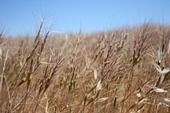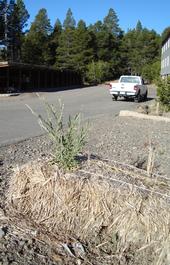- Author: Guy B Kyser
- Contributor: Josh S. Davy
- Contributor: Joseph DiTomaso

The Mediterranean annual grass barb goatgrass (Aegilops triuncialis) is widely hated by land managers, and with good reason. Grazers avoid its tough, silica-rich foliage. In early summer it produces big, centipede-like, spiny-awned seedheads, which we call “crotch rockets” on account of what they do when they get inside your pants leg. Barb goatgrass is also tolerant of serpentine soils, presenting a threat to some California endemic species. Many ranchers consider this grass a greater problem than medusahead.
As with any invasive grass, it is difficult to selectively remove barb goatgrass from grasslands. Because it goes to seed late in the season, after most desirable...
- Author: WSSA
- Re-poster: Brad Hanson
The Weed Science Society of America (WSSA) recently published a press releasee on suggested best management practices for reducing the potential for biofuel crops to become invasive weeds. Jacob Barney from Virginia Tech (and a former UC Weed Science researcher) is highlighted in the press release. I've pasted the text below (in black) or you can click HERE for the direct link. The pdf is also attached at the bottom of this post.
Brad
WSSA SAYS...
- Author: Joseph DiTomaso
Medusahead (Taeniatherum caput-medusae) is one of the most problematic invasive grasses on many California rangelands. It is difficult to control selectively in grasslands. Prescribed burning, grazing, and herbicides have been tested with some success but are not practical in all situations. The selective herbicide Milestone (aminopyralid), normally used for control of certain broadleaf species such as thistles, suppresses some annual grasses when applied pre- or early postemergence. We tested the efficacy of the aminopyralid for medusahead control in preemergence applications at three foothill rangeland sites in northern California. Treatments were applied in early fall 2009 and we evaluated the plots in May 2010. Our results...
- Author: WSSA
- re-poster: Brad Hanson
A quick repost this morning of a recent Weed Science Society of America (WSSA) press release about online databases and smartphone apps for tracking invasive weeds.
Technology that allows integration GPS coordinates and automated (or semi-automated) managment of huge, constantly changing datasets is evolving quickly. The ability for non-technical weed managers to use smartphones to monitor and even help map the location and movement of invasive weeds may allow new opportunities to identify invasions while they are small which can significantly increase the chances for successful eradiction or economical management. Pretty cool stuff!
- Author: Wendy West

The most effective, economical, and ecologically sound method of managing invasive plants is to prevent their invasion in the first place. Resources can be spent most efficiently on proactive activities that focus on stopping the movement of plant seeds and other reproductive parts to new areas.
One way that invasive weed seeds and root fragments can be moved is in hay and straw used for animal feed and bedding or in materials used for erosion control.
Seeds can also be transferred in animal manure if the animal has recently ingested invasive plants in infested feed or while grazing. These seeds and plant parts can then reproduce and colonize a previously uninfested area --- and if left...


